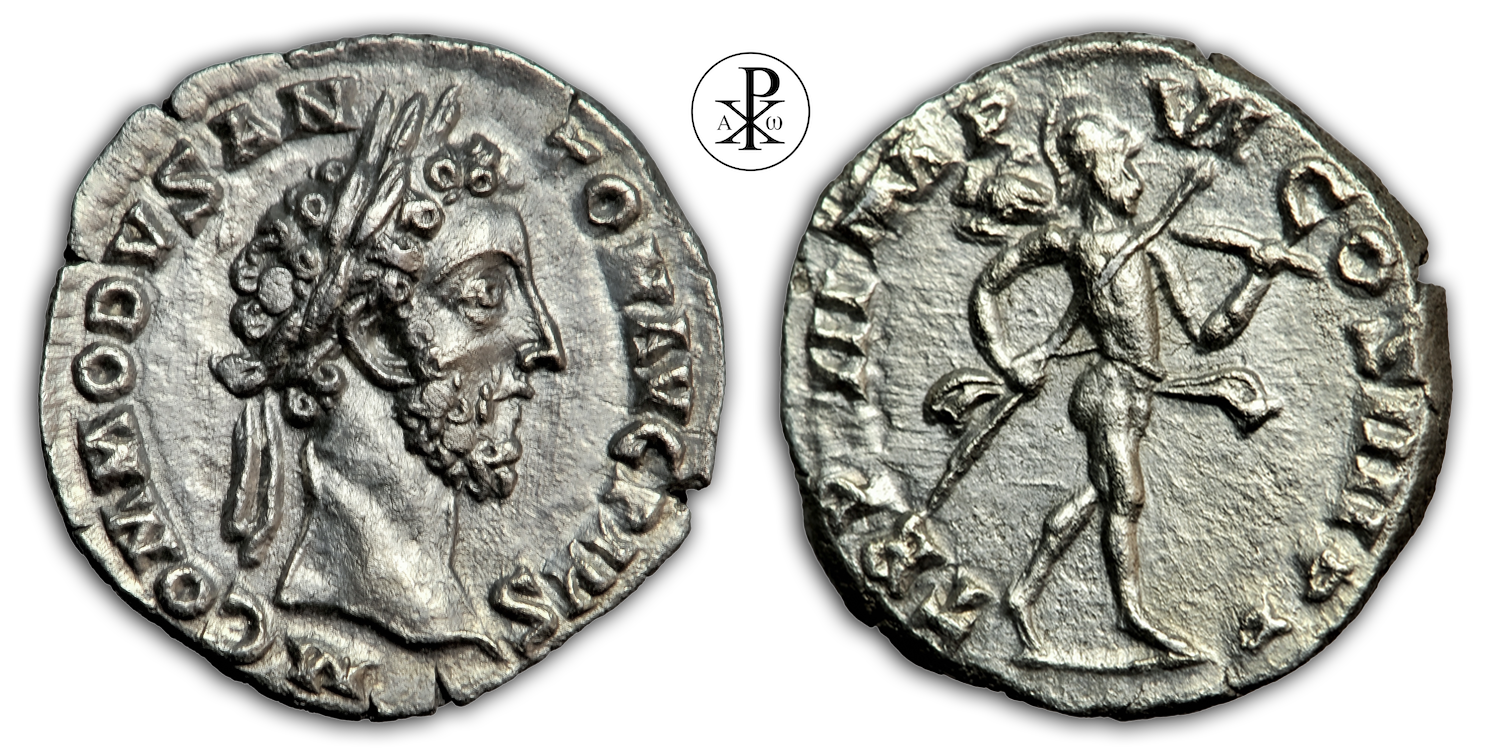Imperator Caesar Marcus Aurelius Commodus Antoninus Augustus
Reign: Commodus
Mint: Rome
Date: 183 AD
Nominal: Denarius
Material: Silver
Diameter: 17mm
Weight: 3.00g
Reference: RIC III Commodus 54
OCRE Online: http://numismatics.org/ocre/id/ric.3.com.54
Rare: R1
Provenance: –
Pedigree: –
Obverse: Head of Commodus, laureate, right
Inscription: M COMMODVS ANTON AVG PIVS
Translation: Marcus Commodus Antoninus Augustus Pius
Reverse: Mars, helmeted, advancing right, holding spear in right hand and trophy sloped over left shoulder in left hand
Inscription: TR P VIII IMP VI COS IIII P P
Translation: Tribunicia Potestate Octava, Imperator Sextum, Consul Quartum, Pater Patriae
Translation: Holder of tribunician power for the eighth time, Imperator for the sixth time, consul for the fourth time, father of the nation
Comment: This type of denarius can be dated by the following titles. The eighth Tribunicia Potestate already began on 10 December 182 AD and ended in rotation on 09 December 183 AD. Since Commodus took up the fourth consulate on 01 January 183 AD, this also dates the earliest possible issue of this type. Commodus accepted the sixth imperial salutation in 183 AD, the seventh imperial salutation in the following year 184 AD – however, the aforementioned inauguration of the ninth Tribunicia Potestate on 10 December 183 AD marks the end of the coinage. So this denarius can be dated well between the beginning and the end of the year 183 AD. In this year Commodus took the epithet Pius after he had, as the senate mocked, designated a paramour of his mother as consul (Comm. 8, 1). In the Arvalactae he already bears this name on 7 January 183 (CIL VI 2099, 12). Apparently at the same time as the adoption of the name Pius, the renewal of the title of Imperator took place (IMP VI is mostly connected with Pius, Cohen 13f. 222. 377. 419. 423. 620-622. 634. 691f. 729. 732. 870-892. 894f. 897-901. 903-911). However, the name Pius is also found in connection with IMP V (Cohen 850-852. 854. 859. 862) as well as IMP VI without Pius (Cohen 893. 896. 902. 912). The reason for the adoption of both titles is unknown. In this new minting period of AD 183, the epithet PIVS becomes established and appears almost invariably and always; with the exception of AE medallions, where it is absent in the majority of cases, again indicating that these specimens were issued at the very beginning of the new minting period. Equally established is the order of the obverse legend with COMMODVS ANTONINVS, which was often reversed before.
Mars was one of the central gods in ancient Italic religion, especially in Rome. He was later equated with the Greek Ares as a god of war, but differed from the latter in his greater importance and more lively cultic worship; he is the most important Roman god along with Jupiter. The names “Ares” and “Mars” could also be etymologically related. Apart from Rome, Mars was worshipped in numerous places in Italy; the people of Mars even derived their name from him. In Rome, Mars formed a trinity of gods together with Jupiter and Quirinus. In the founding legend of Rome, Mars is the father of the twins Romulus and Remus and thus the progenitor of the Romans. The month of March, originally the first month of the year for the Romans, was dedicated to Mars. In March and October, processions were held in honour of Mars on the Field of Mars. Games were held in his honour on 12 May and 1 August. Horses were sacrificed to him on 15 October, as well as cattle for the Suovetaurilia. The priest of Mars in Rome was the Fleming Martialis; in addition, the Salii Palatini performed rites for him. At the feast of Mars (as well as of Quirinus), the dancing priesthood paraded through Rome singing and dancing in ancient war clothing. Originally, Mars was worshipped outside the city on the Campus Martius, named after him, until Augustus had a temple of Mars Ultor (the “avenger”, namely of Caesar’s murderers) built on his forum.
The background for this Mars issue in 183 AD is difficult to grasp historically. The Germanic wars that ended in 180 AD do not come into consideration, nor does the Britannic campaign under Ulpius Marcellus – the Britannic barbarians will not cross the border wall and cut down a Roman detachment until 184 AD. But what was this Mars-type presented here from 183 AD, actively striding, with a victory trophy over his shoulder, referring to? As mentioned in the previous paragraph, in addition to the epithet PIVS, Commodus also adopted the sixth imperatorial salutation in this year (he received the seventh imperatorial salutation in 184 AD through the victory of Ulpius Marcellus in Britain). As already mentioned – the historical reason alone for the adoption of the titles is not known to this day – and thus also not the real reason for the issue of these Mars coinages.
